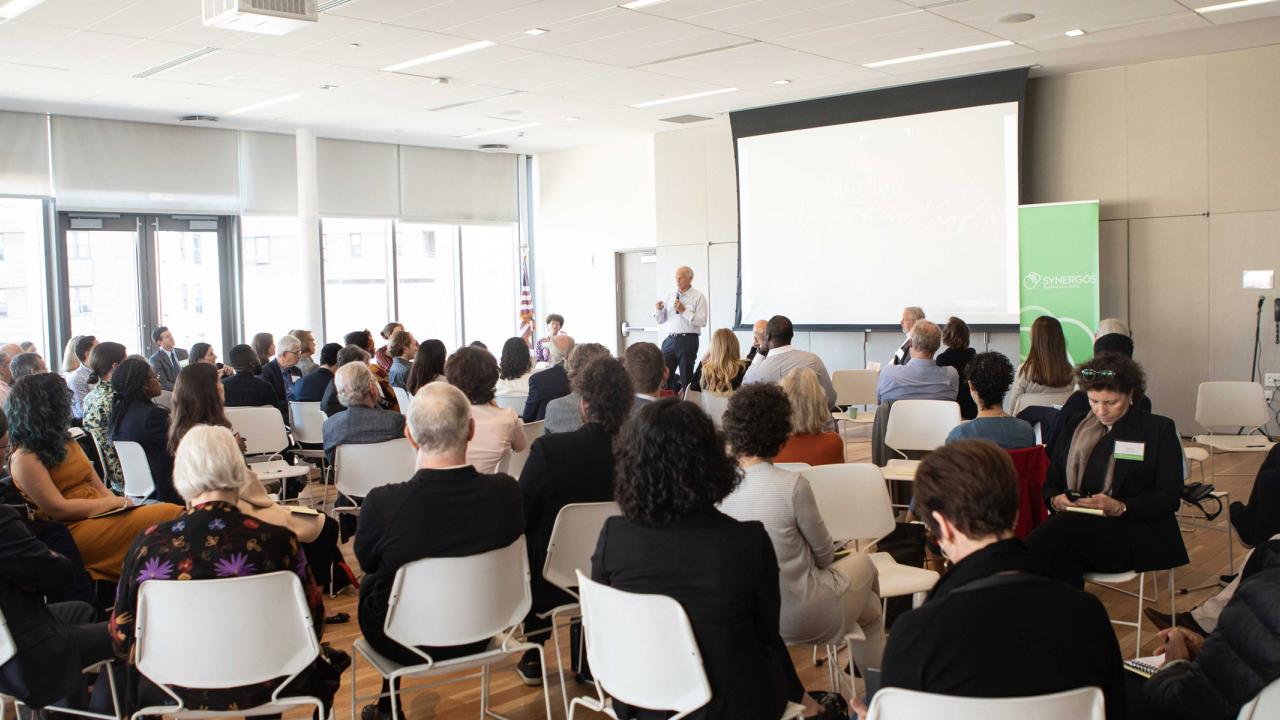
Five Essentials for Bridging Divides to Guide a Change Process
Five Essentials for Bridging Divides to Guide a Change Process
By Swati Chaudhary and Derek Schwabe
At Synergos, we specialize in collaborative solutions to complex social problems. This means bringing together all parties with a stake in fixing the problem to replace many discordant, individual responses with a single, shared one that is aligned and coordinated.
Collective action is admittedly a slower process than going it alone, and often requires limiting the focus to a small first step that all parties can agree on. While the initial result may only be incremental change, we've found that the partnership building process can lay a foundation of trust that supports greater, more sustainable progress over time.
Our recent partnership with leading fashion brands to increase wage digitization in Bangladesh’s garment manufacturing sector offers one example of how a collaborative approach can lay the foundation of trust. It also surfaced five essential practices that we frequently use to facilitate collective change across a range of issues.
A collective approach to wage digitization

For most people in the world, a bank account is essential for simply living life. In many countries, it’s a prerequisite to pay and be paid for just about anything. It’s also a pillar of financial security and poverty reduction in an increasingly digital global economy. When a worker opens an account, they open the door to what is called financial inclusion. Yet in Bangladesh, the majority of garment workers are still paid in cash, a system proven to exclude them from several livelihood-boosting benefits.
When Synergos started its partnership with the fashion companies, most of them were already in agreement on the need to digitize wages for factory workers. However, coordinating across this competitive industry to make it happen was tricky. Using tools from our Bridging Leadership approach, Synergos played a brokering role, guiding the companies to come together and map out an achievable digitization plan. Here are five keys to using the Bridging Leadership approach, which we found relevant for our work on wage digitization.
1: Start by mapping the system
If digitization was good for both companies and workers, why hadn’t it happened already? The answer can be found inside the complex web of a system that is Bangladesh’s garment industry. A host of stakeholders punctuate the sector’s supply chain between the companies and workers and beyond them, including factory owners, suppliers, labor unions, and government and international regulators. Each of these has their own perspective, interests, and influence, and while few of them opposed digitization outright, many had concerns that needed to be acknowledged.
Even the group of companies we partnered with, while influential, represented just a small slice of the hundreds operating in Bangladesh’s garment industry. Thus, understanding the full range of opinions on digitization within the sector demanded a systemic approach, including interviews and conversations that extended beyond partnership members.
2: Use a third party
While the brands we worked with were partners on this project, they were also competitors who vied as much for the same workers as for the same customers. Some were vocal advocates of wage digitization, while others were reluctant, questioning whether it should be their job, as opposed the job of government or international regulators.
The relationship between these companies was complicated and delicate. It necessitated the presence of an objective third party with no stake in the system other than the goal of finding common ground to better the livelihoods of factory workers. By inviting Synergos to play that role, the companies set up an arrangement in which it was easier to express their most honest opinions, since they were no longer talking directly to each other, but to an intermediary.
3: Find the yellow zone

Synergos’ approach prioritized building alignment by finding the common ground between the companies and other stakeholders. By identifying what everyone could agree to accomplish together – and removing everything else – we helped frame an achievable plan.
We talked to all major players in the system on a one-on-one basis to surface metadata on where there was and was not alignment. ‘Red zone’ topics – those that were too divisive – had to be set aside.
After identifying and setting aside areas where there was not common ground, we turned the group’s attention to where there was: the ‘green zone’. Once the green and red zones were clear, it was easier to see the all-important ‘yellow zone’: the in-between space where progress could be made. We asked companies individually what they were open to doing within this zone, and encouraged them to throw out ideas.
4: Extend a safe space to encourage transparency
Understanding the full boundaries of the yellow zone in the wage digitization conversation required transparency on the part of all stakeholders. Synergos used several tools to foster a safe space, where participants felt comfortable enough to be honest. It started with establishing a basis of trust by holding individual conversations with each company, and sometimes even with individual members of a team.
5: Do the unexciting leg work
All the above tactics relied heavily on a great deal of not-so-glamorous ‘leg work’ that proved essential to consensus building. It may go without saying, but consistency in activities like taking notes, setting up meetings, framing constructive agendas, compiling and sifting through interview metadata, and following up mattered immensely.
Also key is the simple need to maintain constant communication with participants, repeatedly confirming observations and decisions made with each member of the group, even when they seem obvious to you (more often than not, they aren’t to others!). This means emailing notes and takeaways, but also regularly checking-in with participants over the phone or in-person.
A flexible model
We’ve used the Bridging Leadership approach to chart a path toward solutions on contentious issues like this all over the world, working at the community level, internationally, and everywhere in between. While the contexts differ and adaptation is essential, these essential lessons broadly apply. Learn more about Bridging Leadership and our other projects at Synergos.org.